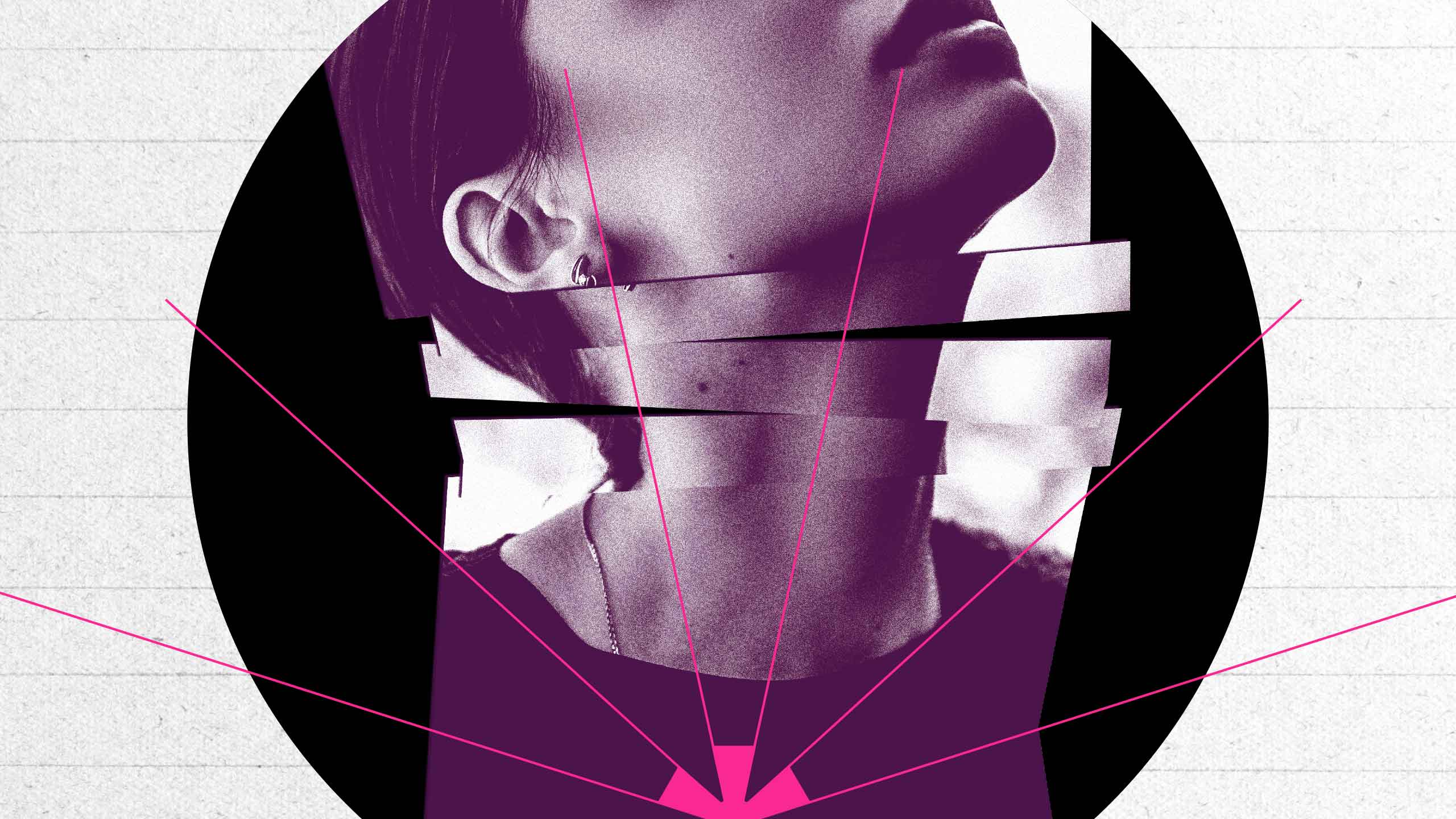A few weeks ago, I was sitting in bed reading aloud from a book. No one was listening to the story I recited other than my phone, which rested in my lap open to a voice recording app. Every few minutes I stopped the recording and raised it to my ear so I could listen back, trying to put embarrassment aside as I studied the sounds my voice was making. It’s difficult to ascertain what your voice sounds like in the moment. Listening back, I can reflect: What qualities in the sound do I like? What qualities do I dislike? How does the pitch sound? Do I want it to sound brighter?
I can only perform this read-and-listen routine three or four times in a row before I become weary of it, no longer attuned to how the recording sounds. We’re all familiar with that grimacing moment when we’re obliged to hear our own voice played back to us. Raise that to the power of dysphoria, and it’s difficult to remain a pseudo-objective critic for long.
I wasn’t putting myself through this rote just to make myself squirm. I’ve been reading book passages aloud to my microphone on and off for a few years with a clear goal in mind: To make my voice sound more “feminine.” It’s a hard slog of a process. I work steadfastly at it for some weeks, then get frustrated or distracted and stop for months on end. Even without the consistency, my voice has changed a lot since I began. Listening to a recording of my voice from 2016 is shocking—I’m not even able to hit that kind of deepness anymore.
Despite these changes, my on-and-off practice hasn’t been sufficient to change my voice as much as I’d like. So halfway through the COVID-19 pandemic, I tried to get more serious about my intention. At that point, I’d been transitioning for about four years and had put a deposit down on a miserably expensive surgery that would feminize the structure of my face. It seemed a bit silly to me: Why bother having my skull shaved if people would still misgender me from how I spoke?
Over the past few months as I worked toward my goal, I began devoting more time to researching voice feminization. In this context, research is synonymous with “logging on.” Due to its quasi-communal format, the internet is often a couple of steps ahead of libraries, health care and academia as a place to learn about transition. Through obscure internet communities and Reddit forums, we can learn about the differences between androcur and spiro for blocking testosterone production, study the benefits of laser in contrast with electrolysis for hair removal or even tap into communal trans wisdom on how to feminize your voice.
Online you can find tips on practice regimens, links to helpful videos, recordings of voices before and after training, PDFs of speech pathology documents and conversations on common hang-ups. Traditionally, when people have things they want to change about their voice they see a voice pathologist (yes, the professionals profiled in the 2010 Academy Award-winning The King’s Speech see non-monarchy patients, too). If a person has a lisp that’s creating social discomfort or a stutter that’s interfering with their career, they’d go consult one of these pathologists.
For trans people, the situation is a bit different. For one, we tend to not enjoy the typically humiliating experience of consulting cis people on transition-related matters, who are also usually ignorant when it comes to serving us. And two, we tend to be impoverished, and speech pathology can be expensive. Speech therapists are generally not covered by public insurance in Canada, though some select practitioners may be.
“Learning to feminize the voice isn’t like learning to ride a bike; it’s like learning to walk with someone else’s feet.”
Voice feminization is a bit more complicated than one might expect. The voice is an exhilaratingly complex thing, flows of sound shaped by a number of muscles and organs. In reductive terms: You push air out your lungs with your diaphragm; the air moves up through the larynx, passing through the vocal folds housed within; the sound caused by the larynx, and shaped by the mouth, tongue, and lips, constitutes a person’s voice. When someone who was assigned male at birth suffers puberty, testosterone causes the larynx to grow, which thickens and lengthens the vocal folds. There is no way to reverse this process, which deepens and darkens the sound of the voice.
Voice feminization is an attempt to mitigate the impacts of testosterone on the vocal tract by changing the way a person speaks. This is an arduous process because speaking is incredibly naturalized and habitual—a person doesn’t think: “Raise the larynx to mid-height, constrict the vocal folds, and move the tongue into position!” every time they speak. Learning to feminize the voice isn’t like learning to ride a bike; it’s like learning to walk with someone else’s feet.
There are three main aspects that make up how a voice’s gender is perceived: Pitch, resonance and intonation. Pitch involves how high or deep a voice sounds. Resonance is how bright or dark a voice is—commonly thought of as the contrast between “head voice” and “chest voice.” Intonation is the flow of speech: melodic or flat, cheerful or gruff. Voice feminization purports to address pitch, resonance and intonation.
Voice training in general differs depending on what purposes it intends to serve. There’s voice training that tries to make you a better public speaker by changing the way you intone and enunciate your words. There’s voice training for people with certain so-called voice pathologies, like stutters or tics that they want to be rid of. And then there’s trans voice training, which uses a similar understanding of the vocal muscles and often similar practice methods as the other kinds of training, but with different aims.
For transfeminine people, trans voice training revolves around three different goals: raising the pitch, brightening the resonance and feminizing the intonation of the voice. In simplistic terms, this is achieved through speaking at a consistently higher pitch, resonating your voice from your head rather than from your chest and speaking in a more melodic, sing-song flow. It is a lot more complicated than it seems, because the goal is to do all this while sounding natural, not like an improv student who could use a few pointers.
July, a trans woman from Montreal, doesn’t remember the first time she heard about voice training. (Xtra has omitted sources full names in this story to protect their identities.) She points to Stef Sanjati, a trans YouTube influencer who’s made videos about her experiences with voice training, as a probable reference point. When July started to medically transition three years ago, she ran into frustrations because of her voice. “I used to get clocked [read as someone who isn’t cisgender] on the phone,” she recalls. Eventually, she had a few lessons with a voice therapist who provided her with tips on resonance and intonation—raising where she feels her voice resonates from and not cutting her sentences so short.
“I felt like it was a caricature of womanhood. I thought, ‘My voice isn’t what defines me as a woman.’”
Despite the useful pointers, July says the lessons also had a negative effect on her dysphoria. “I felt like it was a caricature of womanhood,” she says. “I thought, my voice isn’t what defines me as a woman.” She tried to become more comfortable with her voice by noticing and feeling positive about women with deeper voices. “Being the huge dyke I am, I was lusting over Cate Blanchett’s deep voice,” she jokes. Nonetheless, the lessons did serve a practical purpose: July rarely gets misgendered over the phone anymore and never gets misgendered in real life. She saw the voice therapist out of a private practice, where she paid out of pocket.
Like July, Onnie, another Montreal-based trans woman, recalls originally hearing about voice training through YouTube. Onnie references the channel TransVoiceLessons, an immensely popular platform through which audio engineer and voice expert Zheanna Erose offers insights on vocal training. The channel has gained an almost cult-level status amongst trans women because of the incredible amount of detail and scientific rigour of Zheanna’s videos. “She spoke about voice training in much more grounded terms of resonance, pitch and anatomy that really spoke to my audio engineering side,” Onnie says.
Onnie began to research the fundamentals of voice training because of the dysphoria she felt about her untrained voice. “Even with the changes that came through hormone therapy, I’d be regularly misgendered due to my voice,” she says. After speaking with her doctor, she was referred to a speech pathologist at the McGill University Health Centre. “This was the only possibility of having voice training covered by public insurance in Montreal. But the office closed very early in the day, and there was no way I could regularly commute while working my job,” Onnie says. Eventually she was able to save up the money to pay for lessons herself and reached out to book an appointment with Zheanna. The two have had one session so far, complete with homework and recordings to reference.
I followed a similar path of extracting the most utility out of self-teaching, at which point I sought out an instructor. I became aware of Renée Yoxon through the referral of other trans women who had worked with them in the past on gender-affirming voice training. Yoxon is a transgender, non-binary musician and vocal coach who teaches both cis and trans students. Because of the pandemic, I met them for the first time through the glowing screen of my laptop. I went into our first lesson with a somewhat robust base of knowledge, having spent months and months on forums, watching YouTube channels, reading PDFs and toying with phone apps.
As a trans person who is more attuned toward the convolutions and contradictions of transitioning, Yoxon’s philosophy around voice feminization differs from the typical speech pathologist. “Passing was never my goal with voice training,” they say. “There are so many things the voice can do, it’s exciting! What I’m trying to do is have my clients experience gender euphoria with their voice. I’m trying to help people find a voice that they feel represents them. That voice may pass or it may not; passing is so context-specific.”
“Even at the height of dysphoria-induced self-consciousness, it’s difficult to meaningfully comprehend that I’m biologically constituted.”
My first lesson with Yoxon progressed as I expected: They gave me an overview of how the vocal muscles worked to produce speech and what people listen for when gendering a voice. Then, surprising me, they had me stand up from the chair I was slouching in and start limbering up. “Unclench your shoulders! Make sure your jaw is nice and loose!” they enthused. I felt somewhat sheepish through the impromptu stretching session, but the insight got my brain churning. Despite the vocal fold diagrams and larynx-raising exercises, I still hadn’t understood that my voice is literally a muscle. Even at the height of dysphoria-induced self-consciousness, it’s difficult to meaningfully comprehend that I’m biologically constituted. Part of this is probably in the interests of self-preservation—I’d definitely go Yellow Wallpaper if I was constantly aware of the muscles in my throat.
During my second lesson with Yoxon, they had me try to speak at a higher pitch. I was surprised at how easily it came to me. Speaking in a more feminine way is something I’d practiced for dozens of hours. What was more difficult was getting past the “wall,” which Yoxon described as an issue many of their clients encounter. “There’s a big hump that those practicing voice feminization have to get over between practicing at home and practicing out in the world,” they say.
It reminded me of July’s experience with voice lessons: It can be emotionally difficult to try to feminize your voice. Though in the long run it may alleviate dysphoria, you’re liable to get caught up in a weird, bad dysphoria spiral while you’re still learning. At times when I’m trying to practice, I’ll start feeling terrible about myself—alternating between hyper-fixating on the ways my voice doesn’t sound like it belongs to a woman, and feeling guilty about trying to change it.
The looming spectre of the transgender menace—newly frankensteined by modern TERFs —doesn’t help in this endeavour. Voice training is an especially potent way to summon the timeless ghoul of the male who appropriates the artifice of womanhood. It isn’t like taking hormones (which is a lot less effort), or even like surgery (which is performed by others). Conscious and constant effort is needed, and that brings forth the shame of trying to appear other than as you are. In a word, unnatural.
“In the interests of self-preservation and sustainability, trans girls have adopted a range of tactics to uncomplicate our lives.”
What is wrong with having a voice that’s not stereotypically feminine? The category of woman is resplendent with variability, and a person shouldn’t need to alter what they are to conform with some idealized, patriarchal version of what a woman should be like. Here’s the point at which those unfriendly to us would call us misogynists, and where we would then argue for hours as to whether it is or isn’t misogynistic (it is), and whether we are or aren’t to blame (we aren’t).
But at the end of the day: Who has the energy to be a transgender advocate every time they exist in public? No one can afford the effort it takes to be spokesperson for Normalizing Diverse Womxnhoods each time they buy groceries or mail a letter. In the interests of self-preservation and sustainability, trans girls have adopted a range of tactics to uncomplicate our lives as much as possible. We purport to shimmy down the number of footnotes that mark the narrative of our bodies with each surgery or lesson or layer of makeup. Voice training is just one method in a long line of ways we grow tired of having to constantly negotiate with our surroundings: Disclose, withhold. Avoid him, try her. Speak, stay silent. If the opportunity to opt out of this exhausting and endless parley arises, of course I intend to grab at it. Wouldn’t you?
Ask me how I’m feeling about my voice today, and I’ll tell you I’m still working on it. I’ve accepted that, at this point, I’m probably always going to be working on it in some way or another. It’s just another nebulous part of transition, which is a process about as nebulous as they come. There’s no end to transition, no perfect self that I finally achieve with the 300th hormone dose. It’s an endless process of self-becoming, which is why it’s so deliciously exhilarating. Changing my voice is in the same vein—it drifts over time, changing not only with how I try to train it but also with the influence of aging, of the environment, of the other voices it comes into contact with. I’ve accepted I’m just along for the ride. I’m excited to see where it goes.


 Why you can trust Xtra
Why you can trust Xtra


